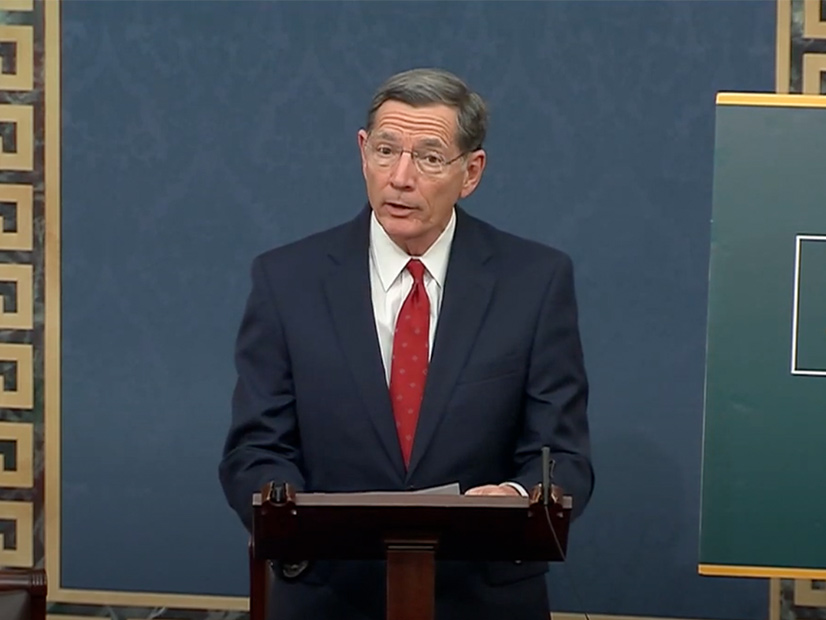Sen. John Barrasso (R-Wyo.) sent a letter to FERC Chairman Richard Glick on Wednesday calling on him to speed up the processing of several matters in front of the commission, including approval of multiple gas pipeline projects and the proposed Southeast Energy Exchange Market (SEEM) (ER21-1111, et al.).
Barrasso, the ranking member of the Senate Energy and Natural Resources Committee, noted “what appear to be irregularities in the processing of important proceedings” in the commission’s electricity and natural gas dockets. The senator cited several specific cases to illustrate his concerns, with specific questions about each in an appendix.
Environmental Studies Push Back Pipelines
In the first section of the letter, Barrasso criticized FERC for notices it issued May 27 in several natural gas certificate proceedings: North Baja Pipeline (CP20-27), Iroquois Gas Transmission System (CP20-48), Tennessee Gas Pipeline (CP20-493), Columbia Gulf Transmission (CP20-527) and Adelphia Gateway (CP21-14).
These notices announced that FERC would prepare an environmental impact statement (EIS) for each project, delaying their approval; Barrasso said similar notices have since been issued in “more than a few other pipeline certificate proceedings,” while the Iroquois project was further delayed on Sept. 2.
The senator said the commission’s actions “indicate that [FERC] is now requiring an EIS in all certificate proceedings and extending schedules for environmental review,” contradicting Glick’s letters of May 21 to Barrasso and other senators in which the chairman said FERC would “not wait to act on certificate applications” for natural gas projects. Barrasso expressed concern about “the imposition of new and as-yet-undefined requirements on certificate applications already under review.”
In the appendix, Barrasso asked FERC for a chart showing the status of certificate applications currently under review, the dates they were filed, and their current stage of review, along with the relevant standard of review and how applicants have been notified of changes to the standard. He also asked whether the commission has “adopted a generally applicable requirement for an EIS regarding gas pipelines,” and if not, why the May 27 and subsequent notices were issued.
In addition, Barrasso questioned whether there are any laws requiring the commission to consider downstream or upstream greenhouse gas emissions of a particular project before issuing a certificate, and how FERC will meet the requirements of the Natural Gas Act to “encourage the development of plentiful supplies of natural gas at reasonable prices” if it does begin to enforce such consideration in the future.
‘Timely Resolution’ Urged on STL Pipeline
The letter’s second section concerns the Spire STL Pipeline, a 65-mile natural gas pipeline for which FERC approved a certificate of public convenience and necessity in August 2018 (CP17-40). Earlier this year the D.C. Circuit Court of Appeals ordered the certificate vacated, saying FERC failed to balance the benefits and adverse impacts of the project. (See DC Circuit Slaps FERC on Pipeline GHG Analysis.)
While FERC granted a temporary certificate for the project on Tuesday “to ensure continuity of service for a limited period while the commission considers appropriate next steps,” Barrasso questioned “why the commission did not act sooner or more definitively to address the issues in this proceeding.” In addition, the senator said that it’s not clear whether FERC is “on a path to a timely resolution of this matter” that will ensure adequate gas supplies in St. Louis during the upcoming winter months.
Barrasso also criticized FERC for setting a 60-day comment cycle on STL’s emergency certificate application, which was submitted July 26. The commission said on Aug. 6 that comments on the application would be due Sept. 7, with reply comments due Oct. 7. Calling this schedule “curious” in light of the “urgent concern” of citizens of the impacted area, the senator asked whether such a comment cycle is common for this kind of emergency application.
Commissioner James Danly dissented in FERC’s latest order, calling it an “unlawful commission response to the judicial vacatur of a certificate, itself a chastisement for our failure to adequately explain our decisions.”
SEEM Delay Questioned
In the final section, Barrasso pushed FERC to move faster on approving SEEM, the planned expansion of bilateral trading in 11 Southeastern states that proponents claim will reduce trading friction while promoting the integration of renewable resources such as wind and solar.
FERC has issued two deficiency letters regarding the proposal this year: the most recent one was in August, 60 days after SEEM’s supporters responded to the commission’s first such notice. (See SEEM Members Push for FERC’s Decision on Market Proposal.) This second letter asked just three questions, prompting Barrasso to ask why it took so long to submit such an apparently simple inquiry. He said “the public record” suggests that FERC is “unnecessarily delaying or impeding” utilities’ attempts to improve the functioning of the wholesale energy market.
“Without speaking to the merits of this particular proposal, I am in favor of voluntary efforts of this type,” Barrasso said. “By allowing incremental voluntary improvements, the commission can enable continuous and orderly market and facility development. Proceeding in this way is time-tested and has enabled the world’s most extensive array of electric infrastructure largely paid for by equity and debt investors to be deployed in the United States.”
FERC may be close to action on the proposal: The sunshine notice for the commission’s meeting next Thursday lists it as the first item in the electric section.



